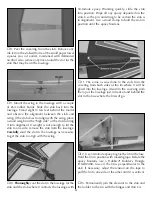
Start with the elevator…
❏
1. Turn on the transmitter and receiver. Holding a
ruler up to the trailing edge of the elevator, move the
elevator all the way up using the control stick on the
transmitter. Measure the distance the elevator moves up.
Also move the elevator down and measure the distance.
As shown in the chart that follows, the elevator should
move up 1/2" [13mm] and down 1/2" [13mm]. If the
elevator moves up or down more than 1/2" [13mm], the
control throw must be
decreased
by connecting the
pushrod to a hole
further out
on the elevator control
horn, or by connecting the pushrod to a hole
further in
on the elevator servo arm (as shown in the sketches
below). If the elevator moves up and down less than
1/2" [13mm], the control throw must be
increased
by
relocating the pushrods the opposite as described.
To get more control surface movement, move the
pushrod farther out on the servo arm. Moving the
pushrod farther inward yields less control surface throw.
To get more control surface movement, move the
pushrod farther in on the control horn. Moving the
pushrod farther out yields less control surface throw.
❏
2. Measure and if necessary, adjust the aileron
and rudder control throws the same way.
IDENTIFY YOUR MODEL
Whether you fly at an R/C club or somewhere on your
own, you should have your name, telephone number
and address in or on your model so it can be identified
and returned in case it lands somewhere away from
the flying site. Fill out the I.D. tag found at the end of
the manual and place it on or inside the model.
BALANCE PROPELLERS
To inexperienced modelers balancing propellers may
seem unnecessary. Balancing propellers could be
equated to changing the oil in your car every 3000
miles. If not done regularly, the car keeps running, but
over time poor maintenance will take its toll. Similarly,
the engine will run and the plane will fly even if the
propeller is not balanced, but over time, not only may
an unbalanced propeller cause engine mounting screws
and bolts to loosen, possibly with disastrous effect, but
vibration may also damage the radio receiver and
battery. Vibration can also cause fuel to foam, which
will, in turn, cause the engine to run hot or quit.
More
Throw
More
Throw
Moving the pushrod inward on the
control horn results in more throw.
More
Throw
More
Movement
Less
Movement
Moving the pushrod outward on the servo
arm results in more pushrod movement.
Control Throws
Elevator
:
1/2" [13mm] up
1/2" [13mm] down
Ailerons
:
3/8" [10mm] up
3/8" [10mm] down
Rudder:
1" [25mm] right
1" [25mm] left
24



















